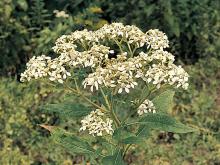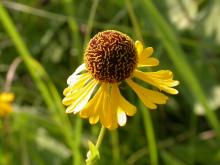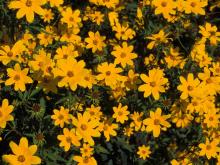Wildflowers, Grasses and Other Nonwoody Plants
Media

Species Types
Scientific Name
Krigia biflora
Description
There are several members of the aster family that look something like common dandelions. But unlike the familiar lawn weed, two-flowered Cynthia is a native Missouri wildflower.
Media

Species Types
Scientific Name
Heterotheca camporum (syn. Chrysopsis villosa var. camporum)
Description
Golden aster can cover entire valleys with its bright yellow flowers. It blooms June through October and is scattered mostly south of the Missouri River.
Media

Species Types
Scientific Name
Verbesina virginica
Description
White crownbeard is a tall native perennial wildflower with clusters of white flowerheads. It's called “wingstem” for the narrow green wings running along the stem. It’s called “frostweed” because it forms "frost flowers": strange and beautiful formations at the stem bases after a sudden hard frost.
Media

Species Types
Scientific Name
Silphium terebinthinaceum
Description
Of Missouri’s six rosinweeds, prairie dock is identified by its large, leathery, unlobed leaves, which are nearly all in a basal whorl. Only a few small leaves grow on the stem.
Media

Species Types
Scientific Name
Ambrosia trifida
Description
Large stands of wind-pollinated giant ragweed commonly form in disturbed areas, causing late-summer misery in the form of hay fever for many Missourians.
Media

Species Types
Scientific Name
Helenium flexuosum
Description
The purplish or brownish disk florets of purple-headed sneezeweed set it apart from our other sneezeweeds, whose centers are yellow. Look for it in moist, open areas, mostly in the southern half of the state.
Media

Species Types
Scientific Name
Bidens aristosa
Description
Tickseed sunflower has flattened black seeds that attach themselves to clothing and pets via two needlelike awns. In flower, it grows in massive displays in moist bottomlands.
Media

Species Types
Scientific Name
Conyza canadensis (formerly Erigeron canadensis)
Description
Horseweed looks something like a goldenrod, except that the tiny composite flowers are not yellow. Instead, they are cream-colored and rather drab. In Missouri, this plant is especially associated with disturbed habitats and is a troublesome crop weed.
Media

Species Types
Scientific Name
Elephantopus carolinianus
Description
You may not recognize elephant’s foot as a member of the daisy or sunflower family because it lacks petal-like ray florets. Also, it has unusual, doubly compound flower clusters. And how did it get its name, anyway?
Media

Species Types
Scientific Name
Helenium amarum
Description
Our weediest sneezeweed, bitterweed arrived in Missouri in the late 1800s from its home range in Texas and Louisiana. Like our other heleniums, it has domed disks and yellow, fan-shaped, notched ray florets. Unlike them, the leaves are narrowly linear.
See Also
About Wildflowers, Grasses and Other Nonwoody Plants in Missouri
A very simple way of thinking about the green world is to divide the vascular plants into two groups: woody and nonwoody (or herbaceous). But this is an artificial division; many plant families include some species that are woody and some that are not. The diversity of nonwoody vascular plants is staggering! Think of all the ferns, grasses, sedges, lilies, peas, sunflowers, nightshades, milkweeds, mustards, mints, and mallows — weeds and wildflowers — and many more!





















